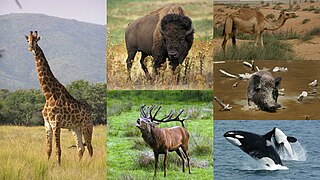
Artiodactyls are placental mammals belonging to the order Artiodactyla. Typically, they are ungulates which bear weight equally on two of their five toes: the third and fourth, often in the form of a hoof. The other three toes are either present, absent, vestigial, or pointing posteriorly. By contrast, most perissodactyls bear weight on an odd number of the five toes. Another difference between the two is that many artiodactyls digest plant cellulose in one or more stomach chambers rather than in their intestine as perissodactyls do. The advent of molecular biology, along with new fossil discoveries, found that cetaceans fall within this taxonomic branch, being most closely related to hippopotamuses. Some modern taxonomists thus apply the name Cetartiodactyla to this group, while others opt to include cetaceans within the existing name of Artiodactyla. Some researchers use "even-toed ungulates" to exclude cetaceans and only include terrestrial artiodactyls, making the term paraphyletic in nature.

Ruminants are herbivorous grazing or browsing artiodactyls belonging to the suborder Ruminantia that are able to acquire nutrients from plant-based food by fermenting it in a specialized stomach prior to digestion, principally through microbial actions. The process, which takes place in the front part of the digestive system and therefore is called foregut fermentation, typically requires the fermented ingesta to be regurgitated and chewed again. The process of rechewing the cud to further break down plant matter and stimulate digestion is called rumination. The word "ruminant" comes from the Latin ruminare, which means "to chew over again".

The Giraffidae are a family of ruminant artiodactyl mammals that share a common ancestor with deer and bovids. This family, once a diverse group spread throughout Eurasia and Africa, presently comprises only two extant genera, the giraffe and the okapi. Both are confined to sub-Saharan Africa: the giraffe to the open savannas, and the okapi to the dense rainforest of the Congo. The two genera look very different on first sight, but share a number of common features, including a long, dark-coloured tongue, lobed canine teeth, and horns covered in skin, called ossicones.
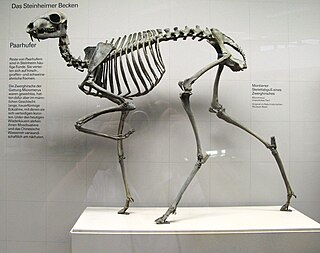
Moschidae is a family of pecoran even-toed ungulates, containing the musk deer (Moschus) and its extinct relatives. They are characterized by long 'saber teeth' instead of horns, antlers or ossicones, modest size and a lack of facial glands. While various Oligocene and Miocene pecorans were previously assigned to this family, recent studies find that most should be assigned to their own clades, although further research would need to confirm these traits. As a result, Micromeryx, Hispanomeryx, and Moschus are the only undisputed moschid members, making them known from at least 18 Ma. The group was abundant across Eurasia and North America during the Miocene, but afterwards declined to only the extant genus Moschus by the early Pleistocene.

Chevrotains, or mouse-deer, are diminutive, even-toed ungulates that make up the family Tragulidae, and are the only living members of the infraorder Tragulina. The 10 extant species are placed in three genera, but several species also are known only from fossils. The extant species are found in forests in South and Southeast Asia; a single species, the water chevrotain, is found in the rainforests of Central and West Africa. They are solitary, or live in loose groupings or pairs, and feed almost exclusively on plant material. Chevrotains are the smallest hoofed mammals in the world. The Asian species weigh between 0.7 and 8.0 kg, while the African chevrotain is considerably larger, at 7–16 kg (15–35 lb). With an average length of 45 cm (18 in) and an average height of 30 cm (12 in), the Java mouse-deer is the smallest surviving ungulate (hoofed) mammal, as well as the smallest artiodactyl. Despite their common name of "mouse deer", they are not closely related to true deer.
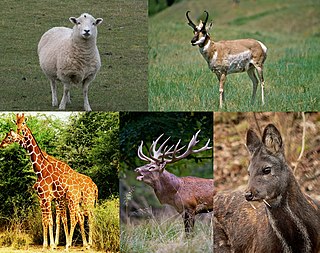
Pecora is an infraorder of even-toed hoofed mammals with ruminant digestion. Most members of Pecora have cranial appendages projecting from their frontal bones; only two extant genera lack them, Hydropotes and Moschus. The name "Pecora" comes from the Latin word pecus, which means "cattle". Although most pecorans have cranial appendages, only some of these are properly called "horns", and many scientists agree that these appendages did not arise from a common ancestor, but instead evolved independently on at least two occasions. Likewise, while Pecora as a group is supported by both molecular and morphological studies, morphological support for interrelationships between pecoran families is disputed.
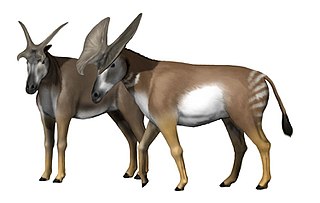
Prolibytherium is an extinct genus of prolibytheriid artiodactyl ungulate native to Middle Miocene North Africa and Pakistan, from around 16.9 to 15.97 million years ago. Fossils of Prolibytherium were found in the Marada Formation of Libya, Vihowa Formation of Pakistan, and the Moghara Formation of Egypt.
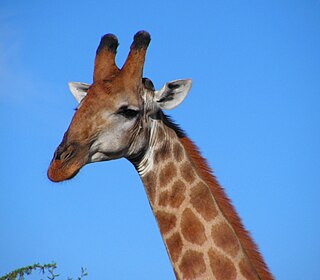
Ossicones are columnar or conical skin-covered bone structures on the heads of giraffes, male okapi, and some of their extinct relatives. Ossicones are distinguished from the superficially similar structures of horns and antlers by their unique development and a permanent covering of skin and fur.
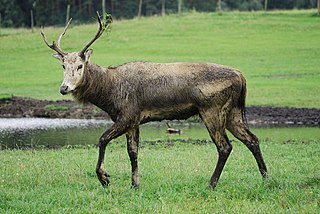
The Cervinae or the Old World deer, are a subfamily of deer. Alternatively, they are known as the plesiometacarpal deer, due to having lost the parts of the second and fifth metacarpal bones closest to the foot, distinct from the telemetacarpal deer of the Capreolinae.

The Cetruminantia are a clade made up of the Cetancodontamorpha and their closest living relatives, the Ruminantia.
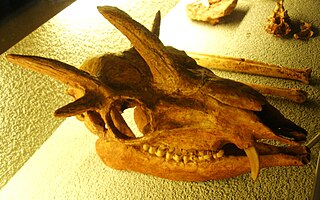
Hoplitomeryx is a genus of extinct deer-like ruminants which lived on the former Gargano Island during the Miocene and the Early Pliocene, now a peninsula on the east coast of South Italy. Hoplitomeryx, also known as "prongdeer", had five horns and sabre-like upper canines similar to a modern musk deer.

The Palaeomerycidae is an extinct family of Neogene ruminants belonging to the infraorder Pecora. Palaeomerycids lived in Europe and Asia exclusively during the Miocene, coevolving with cervids, bovids, moschids, and tragulids there as part of a dramatic radiation of ruminants by the early Miocene.
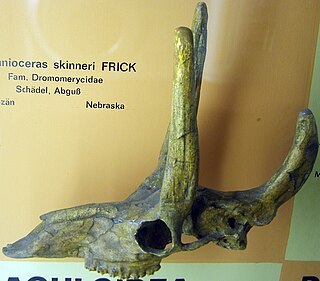
The Dromomerycidae is an extinct family of Neogene ruminants belonging to the infraorder Pecora. Dromomerycids, known by two subfamilies, were endemic to North America from the later early Miocene up to the early Pliocene, leaving no descendants. Dromomerycidae has a long history of uncertain taxonomic affiliations due to its superficial resemblances with the Eurasian Neogene Palaeomerycidae and were traditionally classified as subfamilies within the family. However, recent research differentiates the dromomerycids from the Giraffomorpha by the lack of sutures on the skull roof that typically make up the ossicones of the later clade. The similar resemblances of the appendages therefore could be the result of parallel evolution.

Micromeryx is an extinct genus of musk deer that lived during the Miocene epoch. Fossil remains were found in Europe and Asia. The earliest record (MN4) of the genus comes from the Sibnica 4 paleontological site near Rekovac in Serbia.
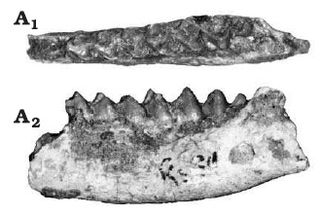
Afrotragulus is an extinct genus of tragulid ruminant which existed in Kenya during the early Miocene period. It contains the species Afrotragulus moruorotensis and Afrotragulus parvus, formerly classified in genus Dorcatherium, as well as A. akhtari, A. megalomilos, and A. moralesi.
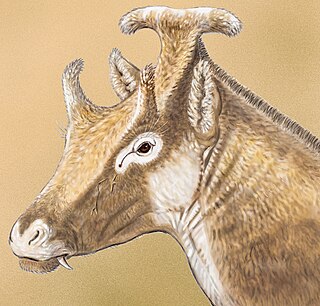
Xenokeryx is an extinct genus of ruminant known from the Miocene of Europe. The type species, Xenokeryx amidalae, was recovered from central Spain and bears a unique T-shaped protrusion from the top of the head. The specific epithet amidalae is in reference to the character Padmé Amidala from the Star Wars films "due to the striking resemblance that the occipital appendage of Xenokeryx bears to one of the hairstyles that the aforementioned character shows in The Phantom Menace feature film."
For some 10 million years until the end of the Eocene, Balkanatolia was an island continent or a series of islands, separate from Asia and also from Western Europe. The area now comprises approximately the modern Balkans and Anatolia. Fossil mammals from this area are distinct from the mammal fauna of either western Europe or Asia.

Bachitherium is an extinct genus of Paleogene ruminants that lived in Europe from the late Eocene to the late Oligocene. The genus was erected in 1882 by Henri Filhol based on fossil remains found in the Quercy Phosphorites Formation. Bachitherium curtum was defined the type species, and another species called B. insigne; five more species have since been named although one, B. sardus, is currently pending reassessment. The genus name derives from "Bach", the French locality where its first fossils were found, and the Greek θήρ/therium meaning "beast". Bachitherium has historically been assigned to various families within the ruminant infrorder Tragulina, but was reclassified to its own monotypic family Bachitheriidae by Christine Janis in 1987.

Bovoidea is a superfamily of pecoran ruminants containing the Bovidae and Moschidae. The Bovoidea today is defined in part by very specific dental and anatomical traits, and genetic research indicates that the Moschidae is the sister taxon to the Bovidae.
Propalaeoryx is an extinct genus of African Giraffomorpha with two species currently known being Propalaeoryx austrofricanus and Propalaeoryx nyanae, both living in Namibia during the early Miocene epoch.


















